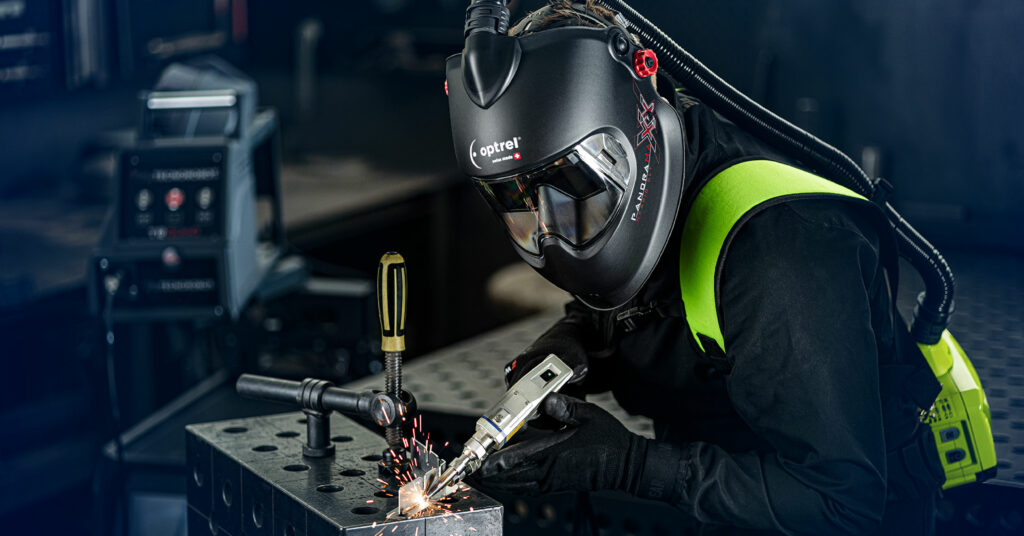Laser welding is a cutting-edge process known for its precision, speed, and minimal heat input. However, the high-energy laser beam creates a significant, often overlooked hazard: ultra-fine weld fumes and particulates. To safeguard your long-term health and career, a Powered Air-Purifying Respirator (PAPR) isn’t just a recommendation—it’s essential for laser welding.
The Hidden Danger of Laser Welding Fumes
While laser welding might not produce the visibly heavy smoke associated with traditional arc welding, it creates a silent, more dangerous threat: submicron particulates.
- Ultra-Fine Particles: The intense energy of the laser beam vaporizes metal, creating extremely fine particles. These particles, often submicron in size, are so small they can be inhaled deep into the lungs, bypassing the body’s natural defenses and potentially causing serious respiratory and systemic health issues.
- Toxic Components: The fumes contain a “cocktail” of hazardous materials, including metal oxides like manganese, zinc, aluminum, and highly toxic substances such as hexavalent chromium (Cr(VI)) if stainless steel is being welded. Prolonged exposure can lead to severe health risks, including:
-
- Pneumonitis and Metal Fume Fever
-
- Asthma and Chronic Obstructive Pulmonary Disease (COPD)
-
- Irreversible damage to the neurological system
-
- Elevated risk of various cancers
Engineering controls, such as local exhaust ventilation, are the primary line of defense. However, when these controls are insufficient when welding in confined or poorly ventilated spaces, Personal Protective Equipment (PPE) is mandatory. This is where a PAPR system shines.
Why PAPR Systems Surpass Standard Filtration
In the demanding environment of high-precision laser welding, a disposable or non-powered mask simply cannot offer the protection or sustained comfort required. PAPR systems provide a quantum leap forward in safety technology:
- Superior, Certified Filtration: A PAPR utilizes a battery-powered blower to actively pull ambient air through a high-efficiency particulate air (HEPA) filter. These filters are rigorously tested to capture 99.97% of airborne particles. This is crucial for laser welding, as HEPA filtration is effective against the dangerous submicron particles that pose the greatest respiratory threat.
- Constant Positive Pressure: The motorized blower creates a continuous stream of filtered air, maintaining a slight positive pressure inside the helmet or hood. This is the ultimate defense against fine laser fumes: any slight gap or movement around the face seal means clean air is always escaping rather than contaminated air being pulled in.
- Unmatched Comfort for Long Shifts: The constant, gentle airflow eliminates the breathing resistance common to non-powered respirators, reducing fatigue. Furthermore, the air circulation cools the wearer and actively reduces heat and humidity inside the helmet, preventing lens fogging and increasing focus during critical, long-duration welds.
NIOSH Approval: Your Assurance of Performance
When selecting respiratory protection, the certification stamp of the National Institute for Occupational Safety and Health (NIOSH) is the only true guarantee of quality and performance.
A NIOSH-approved PAPR system confirms:
- Tested Efficiency: The filter media (typically P100/HEPA in PAPR systems) has been independently verified to perform as claimed, effectively removing the specified percentage of particulates down to 0.3 micrometers.
- System Integrity: The entire unit—blower, battery, hose, and headpiece—is tested as a single system to ensure consistent delivery of the required air volume and positive pressure.
- Built-in Reliability: NIOSH-approved units feature mandatory low-battery and low-airflow alarms (audible, vibrating, or visual). This critical fail-safe immediately notifies the user if the protection level is compromised, providing peace of mind and ensuring maximum safety.
The optrel Advantage: Full-Spectrum Safety
As leaders in both advanced welding optics and high-performance respiratory systems, optrel understands that safety for laser welding requires a dual approach: protecting your vision from the laser’s energy and protecting your lungs from its fumes.
This is why optrel designs advanced, integrated systems. These systems are anchored by units like the NIOSH-approved optrel e3000X PAPR, which is designed to integrate seamlessly not only with traditional welding helmets but also with specialized, high-quality laser safety helmets. Our premier example is the panoramaxx laser pure air, which is the only NIOSH-approved PAPR design specifically engineered for laser welding safety. By choosing an approved, integrated system, you secure the clarity needed to perfect your welds and the certified protection required to breathe easier.
Ready to upgrade your protection? Explore the e3000X PAPR system, the unique panoramaxx laser pure air, and our full line of safety solutions tailored for the precision of laser welding.
